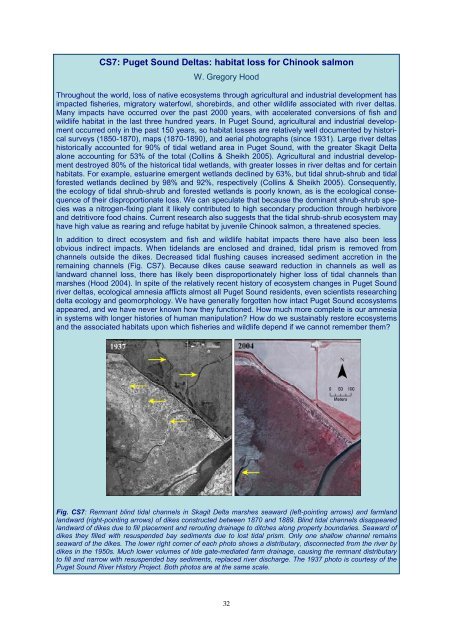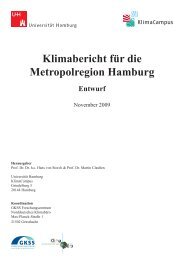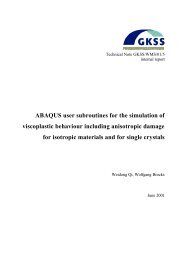Dynamics and Vulnerability of Delta Systems - loicz
Dynamics and Vulnerability of Delta Systems - loicz
Dynamics and Vulnerability of Delta Systems - loicz
Create successful ePaper yourself
Turn your PDF publications into a flip-book with our unique Google optimized e-Paper software.
CS7: Puget Sound <strong>Delta</strong>s: habitat loss for Chinook salmon<br />
W. Gregory Hood<br />
Throughout the world, loss <strong>of</strong> native ecosystems through agricultural <strong>and</strong> industrial development has<br />
impacted fisheries, migratory waterfowl, shorebirds, <strong>and</strong> other wildlife associated with river deltas.<br />
Many impacts have occurred over the past 2000 years, with accelerated conversions <strong>of</strong> fish <strong>and</strong><br />
wildlife habitat in the last three hundred years. In Puget Sound, agricultural <strong>and</strong> industrial development<br />
occurred only in the past 150 years, so habitat losses are relatively well documented by historical<br />
surveys (1850-1870), maps (1870-1890), <strong>and</strong> aerial photographs (since 1931). Large river deltas<br />
historically accounted for 90% <strong>of</strong> tidal wetl<strong>and</strong> area in Puget Sound, with the greater Skagit <strong>Delta</strong><br />
alone accounting for 53% <strong>of</strong> the total (Collins & Sheikh 2005). Agricultural <strong>and</strong> industrial development<br />
destroyed 80% <strong>of</strong> the historical tidal wetl<strong>and</strong>s, with greater losses in river deltas <strong>and</strong> for certain<br />
habitats. For example, estuarine emergent wetl<strong>and</strong>s declined by 63%, but tidal shrub-shrub <strong>and</strong> tidal<br />
forested wetl<strong>and</strong>s declined by 98% <strong>and</strong> 92%, respectively (Collins & Sheikh 2005). Consequently,<br />
the ecology <strong>of</strong> tidal shrub-shrub <strong>and</strong> forested wetl<strong>and</strong>s is poorly known, as is the ecological consequence<br />
<strong>of</strong> their disproportionate loss. We can speculate that because the dominant shrub-shrub species<br />
was a nitrogen-fixing plant it likely contributed to high secondary production through herbivore<br />
<strong>and</strong> detritivore food chains. Current research also suggests that the tidal shrub-shrub ecosystem may<br />
have high value as rearing <strong>and</strong> refuge habitat by juvenile Chinook salmon, a threatened species.<br />
In addition to direct ecosystem <strong>and</strong> fish <strong>and</strong> wildlife habitat impacts there have also been less<br />
obvious indirect impacts. When tidel<strong>and</strong>s are enclosed <strong>and</strong> drained, tidal prism is removed from<br />
channels outside the dikes. Decreased tidal flushing causes increased sediment accretion in the<br />
remaining channels (Fig. CS7). Because dikes cause seaward reduction in channels as well as<br />
l<strong>and</strong>ward channel loss, there has likely been disproportionately higher loss <strong>of</strong> tidal channels than<br />
marshes (Hood 2004). In spite <strong>of</strong> the relatively recent history <strong>of</strong> ecosystem changes in Puget Sound<br />
river deltas, ecological amnesia afflicts almost all Puget Sound residents, even scientists researching<br />
delta ecology <strong>and</strong> geomorphology. We have generally forgotten how intact Puget Sound ecosystems<br />
appeared, <strong>and</strong> we have never known how they functioned. How much more complete is our amnesia<br />
in systems with longer histories <strong>of</strong> human manipulation? How do we sustainably restore ecosystems<br />
<strong>and</strong> the associated habitats upon which fisheries <strong>and</strong> wildlife depend if we cannot remember them?<br />
Fig. CS7: Remnant blind tidal channels in Skagit <strong>Delta</strong> marshes seaward (left-pointing arrows) <strong>and</strong> farml<strong>and</strong><br />
l<strong>and</strong>ward (right-pointing arrows) <strong>of</strong> dikes constructed between 1870 <strong>and</strong> 1889. Blind tidal channels disappeared<br />
l<strong>and</strong>ward <strong>of</strong> dikes due to fill placement <strong>and</strong> rerouting drainage to ditches along property boundaries. Seaward <strong>of</strong><br />
dikes they filled with resuspended bay sediments due to lost tidal prism. Only one shallow channel remains<br />
seaward <strong>of</strong> the dikes. The lower right corner <strong>of</strong> each photo shows a distributary, disconnected from the river by<br />
dikes in the 1950s. Much lower volumes <strong>of</strong> tide gate-mediated farm drainage, causing the remnant distributary<br />
to fill <strong>and</strong> narrow with resuspended bay sediments, replaced river discharge. The 1937 photo is courtesy <strong>of</strong> the<br />
Puget Sound River History Project. Both photos are at the same scale.<br />
32





